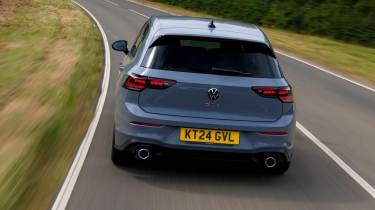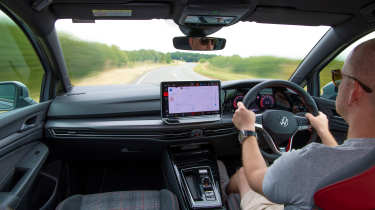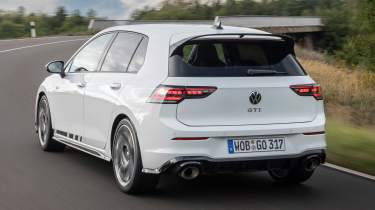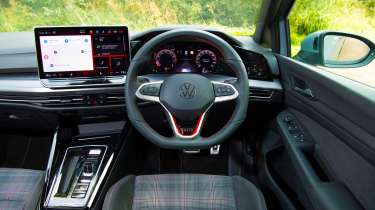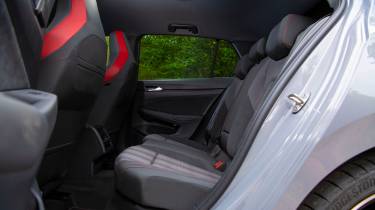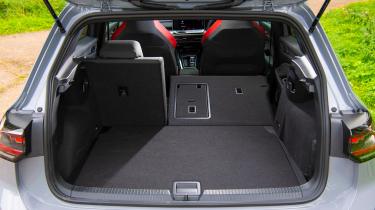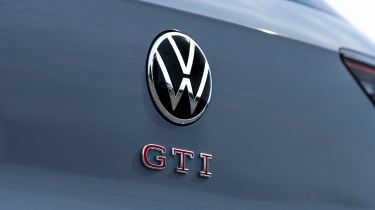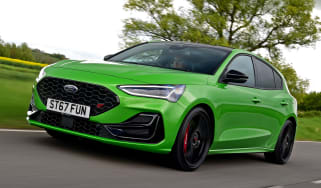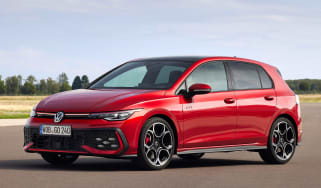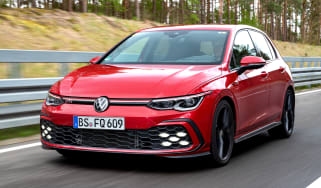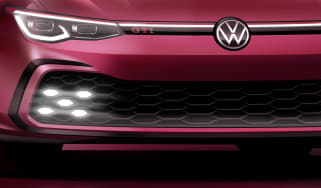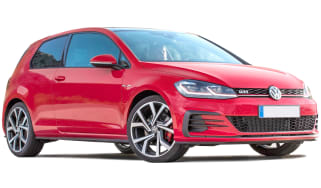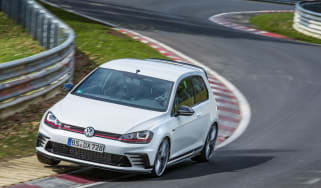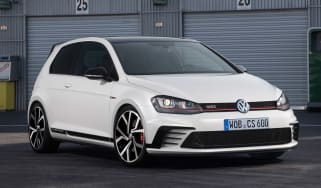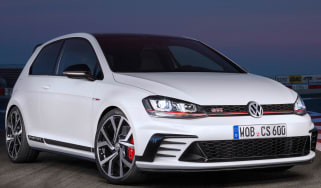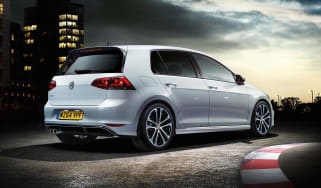Volkswagen Golf GTI review – the quintessential hot hatch
"Favouring precision over power, the Volkswagen Golf GTI is a sophisticated hot hatch"
Pros
- Great chassis
- Iconic badge
- Easy to live with
Cons
- Rivals are faster
- Dull exhaust note
- No manual option
Verdict – is the Volkswagen Golf GTI a good car?
The Volkswagen Golf GTI is the closest thing hot hatch fans have to the Porsche 911. Not only is it a German performance icon, but like the 911, Volkswagen has developed the GTI continually for nearly five decades, improving performance, refinement and safety, but keeping the spirit of the original – the facelifted car is an improvement, but we can’t help but miss the more involving six-speed manual version. If you want the ultimate in engagement, the GTI Clubsport is well worth the £2,300 price hike, delivering a more potent hit of adrenaline when you go for it.
Volkswagen Golf GTI models, specs and alternatives
The Volkswagen Golf GTI is an iconic nameplate for the brand, having been around for almost half a century. It started as a pioneer for the hot hatchback class, bringing big power and fun to its Golf family hatchback and proving you didn’t need to forgo everyday practicality like you do with most sports cars.
The Golf and Golf GTI are now in their eighth generation with both models getting a refresh just in time for the standard Golf’s 50th anniversary in 2024. The facelift sees a mild update to the Golf GTI’s exterior, with slimmer headlights that feature matrix-LED tech and revised rear light signatures, but most of the tweaks are less noticeable at first glance.
More reviews
Car trim reviews
In-depth reviews
- Volkswagen Golf R review – the ultimate hot Golf
- Volkswagen Golf review - the go-to family hatchback
- Volkswagen Golf R estate review
Used car reviews
The truth is that the Golf – and therefore Golf GTI – suffered from some disappointingly frustrating ergonomic foibles in the interior, such as the lack of backlit buttons for the climate controls and overengineered haptic controls on the steering wheel. Thankfully most of these issues have been addressed as part of the most recent facelift, and the infotainment screen has also got larger and has improved software that’s more intuitive to use.
Now the standard Golf GTI is more powerful, with 261bhp from its 2.0-litre turbocharged engine compared to the outgoing version’s 242bhp figure. That means the 0-62mph time is quicker, shaving 0.4 seconds off the old car’s sprint time for a total of 5.9 seconds. As before there’s an even punchier GTI Clubsport that sits above it with 296bhp, while the four-wheel drive Golf R is slightly more powerful again.
Some may lament the absence of a manual transmission option – that was dropped in 2023 – with all GTIs now getting a DSG automatic. The Golf GTI can be had with adaptive suspension, and features switchable driving modes, the limited-slip differential from the expensive Golf GTI TCR and a system capable of adjusting both up to 200 times a second make the GTI more capable than ever. It has more grip and resists understeer even more doggedly, all while remaining composed and comfortable on the school run.
 The 10 best hot hatchbacks to buy in 2025
The 10 best hot hatchbacks to buy in 2025
Alloy wheels are 18 inches as standard with 19-inch versions available as options. The GTI Clubsport gets a more aggressive look, with a unique front bumper, sill extensions and a much larger rear wing, while the Clubsport 45 had a black roof and unique alloy wheels with a red pinstripe.
The interior gets the usual list of GTI upgrades, from tartan-cloth bucket seats to steel pedals and a sports steering wheel. There's also ambient lighting with a GTI-inspired setting, and sporty graphics for the digital instrument panel.
MPG, running costs & CO2
The Volkswagen Golf GTI has a reputation as the everyman's performance car, and a big part of this is its palatable running costs. The GTI can return up to 39.8mpg, while emitting 162g/km of CO2. The figures are only a little less economical for the Clubsport version, despite its higher power output, with a combined economy figure of 37.2mpg, and CO2 emissions of 171g/km. The Ford Focus ST, with its larger 2.3-litre engine, only manages 35.8mpg and emits 182g/km.
As a private buyer, the usefully frugal nature of the latest GTI will mean fewer trips to the pumps, and given the GTI is probably not a fixture of company car lists to the same extent it used to be, the fact that it sits in the highest Benefit-in-Kind band probably isn’t a big problem – these days you’re more likely to be pushed towards cleaner, electrified models like the Toyota Prius, Volkswagen’s own Golf GTE plug-in hybrid or an EV like the Cupra Born.
At least the annual VED (road tax) bill is reasonable because it's charged at the standard rate. However, from April 2025 the first-year rate will double, making it a more noticeable bill than ever before. The GTI Clubsport model starts at over £40,000 (the regular GTI misses this figure by a whisker), meaning owners will be liable for the additional surcharge for years two to six of ownership. The GTI shouldn't cost much more than a regular Golf when it comes to servicing and maintenance. Consumables like tyres and brakes could be a bit more expensive though, especially for the Clubsport, due to their high-performance specifications.
Engines, drive & performance
While the standard Golf GTI’s power figure has had a boost for the facelift, going from 242bhp to 261bhp, you might be hard-pressed to notice unless you really wring it out to the redline where it feels much punchier than before. The 0-62mph acceleration time has been cut by 0.4 seconds, so now the GTI does the sprint in 5.9 seconds. As before, a healthy amount of shove low down means the GTI feels as eager as always, but we’ll admit that aside from a few pops and bangs the four-cylinder engine doesn’t provide much in the way of drama.
The real test of a good hot hatchback, however, is its capability through the twisties. As has long been the case for the Golf GTI, it feels more polished than rivals. There’s loads of grip from the front wheels, so the Golf GTI can be driven with confidence, and it feels planted. Admittedly some may prefer the involvement and playfulness offered by the Ford Focus ST or Honda Civic Type-R, but the Volkswagen is still lots of fun and arguably easier to live with.
It’s a shame the Volkswagen Golf GTI is no longer offered with a manual gearbox, and that’s where some driving enthusiasts might turn to the ST or the Type-R. Don’t get us wrong, as the seven-speed DSG automatic gearbox in the GTI is sharp and responsive, but it comes at the expense of driver engagement.
Inevitably, the Golf GTI suffers from slightly more road noise than a standard Golf given its low-profile tyres, but the tradeoff really isn’t as bad as you might expect and refinement is impressive. We’d recommend opting for the Adaptive Chassis Control for an extra £700, however. This adds electronically controlled adaptive dampers with 15 different settings allowing you to turn it into a track-focused machine one minute, a relaxing road car the next, or something somewhere in between.
The facelifted model sees the return of the GTI Clubsport which ups the ante for the hot hatchback, bringing a higher 296bhp figure and quicker 0-62mph time of 5.6 seconds. If you’re a keen hot hatch enthusiast, the extra £2,300 seems like a bit of a bargain, because this is the most fun Golf we’ve driven, including the more expensive Golf R.
While the GTI Clubsport might not be as outright fast as the R, especially in poor weather, the former is more engaging more of the time. Its responses are somewhat blunted in Comfort mode, presumably to make the car easier to drive in town and heavy traffic, but switch to one of the more focused driving modes – including a Special mode aimed at the Nurburgring circuit – and the Clubsport feels alive. It weighs 90kg less than the Golf R, and its tweaked steering, electronic differential and adaptive suspension helps it cling on impressively well in corners.
Interior & comfort
If you've sat in a Golf GTI in any of its previous seven incarnations, you'll be instantly familiar with the interior theme of the eighth. There are tartan-trimmed seats with noticeably larger side bolsters than the regular car, and these gain integrated headrests for the first time. There are red flashes of trim – the GTI signature colour – and steel pedals. The digital instrument panel has also allowed for a virtual upgrade, with bespoke GTI graphics.
Of course, the steering wheel is important in any GTI, and there’s a flat-bottomed item with exaggerated hand grips at either side, metallic bottom spokes and a GTI badge. The rest of the changes fall in line with the regular Mk8.5 Golf but transform the interior into a digital environment. One important change over the pre-facelift car, we’re happy to report, is the introduction of a backlit control bar under the infotainment screen, and the removal of the frustrating touch-sensitive steering wheel buttons in favour of good old-fashioned physical buttons.
There’s also a new, larger 12.9-inch infotainment screen perched on top of the middle of the dashboard. It’s a marked improvement over the old system, even if it doesn’t quite flow as seamlessly into the driver’s binnacle. The software is much snappier and more responsive, and while we’d still prefer physical climate controls, they’re now at least permanently displayed on-screen, negating the need to click through multiple submenus to access them.
Aside from the performance upgrades, the Clubsport gets added exterior decals and a more aggressive bodykit and large spoiler. There are also uprated brake discs and a locking front differential adding to the car’s ability to put power down effectively and improve stopping power.
Practicality & boot space
As three-door models have fallen out of favour with buyers, manufacturers have managed to save on the cost of engineering a different body shell. The Mk8 GTI is five-door only, with virtually no loss in practicality versus the standard model. It's easy to get in and out – so long as you don't mind climbing around the more prominent front seat bolsters – or put a child seat in the back, with plenty of room for four adults.
It’s worth noting that the bucket seats in the GTI Clubsport were somewhat bulky, reducing rear seat knee room to the point where we reckon they’d only be suitable for kids or small adults. In the standard GTI it’s possible to get three people in the back, but the Ford Focus ST is slightly more roomy, while the Octavia vRS boasts more legroom. Impressively there are three ISOFIX child seat mounting points; two in the outer rear seats and one in the front passenger seat.
Oddment storage is pretty good too, with a sizeable glovebox and deep carpet-lined door bins to help stop items from rattling around. It even boasts a wireless charging spot that’s designed to stop your phone from flying around the cabin at every corner.
With no four-wheel drive or electrification taking up extra space (if you want the latter, Volkswagen also offers the sporty Golf GTE), the boot measures 374 litres, so there's no lack of practicality compared with the standard Golf. Still, it’s not class-leading – the Honda Civic Type R offers 420 litres and the Skoda Octavia vRS is even better with 600 litres. Fold the seats down and space increases to 1,237 litres of space.
While a Golf GTI might not seem like the most obvious choice of tow car, it’s rated to pull up to a respectable 1,600kg, should you want to pull a small trailer or even a caravan.
Reliability & safety
The regular Volkswagen Golf last featured in our Driver Power customer satisfaction survey in last place out of the top 50 models in 2024 – while it scored behind most other cars in all categories, its best results were in running costs and practicality, the latter of which is still applicable to the GTI model. As a brand, Volkswagen finished an unimpressive 29th place out of 32 manufacturers in our 2024 survey. Reliability was middle of the road, with around 23% of VW owners reporting an issue in the first year. Given that the new GTI shares its technology and underpinnings with the regular Golf, and that it uses the same 2.0-litre petrol engine as before, there shouldn't be too many surprises. Small faults are likely to be software-based and electrical.
It's good news so far as safety is concerned, thanks to a solid five-star Euro NCAP rating for the standard Golf. It now comes with a list of safety kit beyond that of a luxury saloon from just a few years ago, including LED Matrix headlights, driving aids and Car2X – a communication technology that can receive information and hazard warnings from local infrastructure and even nearby vehicles.
There’s also an Emergency Assist function that can step in if the driver doesn’t touch the steering wheel for 10 seconds or more, first with visual and audible warnings, then a jolt of the brakes and finally the ability to slow and steer the car to a safe stop.

